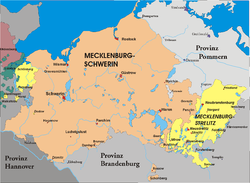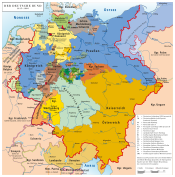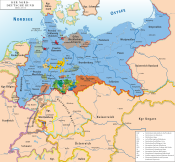Grand Duchy of Mecklenburg-Schwerin
Grand Duchy of Mecklenburg-Schwerin Großherzogtum Mecklenburg-Schwerin (German) | |||||||||
|---|---|---|---|---|---|---|---|---|---|
| 1815–1918 | |||||||||
| Motto: sic itur ad astra thus one journeys to the stars | |||||||||
 The Grand Duchy of Mecklenburg-Schwerin within the German Empire | |||||||||
 Map of Mecklenburg-Schwerin (orange) | |||||||||
| Status |
| ||||||||
| Capital | Schwerin 53°38′0″N 11°25′0″E / 53.63333°N 11.41667°E | ||||||||
| Common languages | Evangelical Lutheran State Church of Mecklenburg-Schwerin | ||||||||
| Government | Constitutional monarchy | ||||||||
| Grand Duke | |||||||||
• 1815–1837 | Frederick Francis I | ||||||||
• 1837–1842 | Paul Frederick | ||||||||
• 1842–1883 | Frederick Francis II | ||||||||
• 1883–1897 | Frederick Francis III | ||||||||
• 1897–1918 | Frederick Francis IV | ||||||||
| History | |||||||||
• German Revolution | 14 November 1918 | ||||||||
| Currency | German gold mark (1873–1918) | ||||||||
| |||||||||
| Today part of | Germany | ||||||||

The Grand Duchy of Mecklenburg-Schwerin (German: Großherzogtum Mecklenburg-Schwerin) was a territory in Northern Germany held by the House of Mecklenburg residing at Schwerin. It was a sovereign member state of the German Confederation and became a federated state of the North German Confederation and finally of the German Empire in 1871.
Geography
Like its predecessor, the Duchy of Mecklenburg-Schwerin, the Schwerin lands upon the incorporation of the extinct Duchy of Mecklenburg-Güstrow in 1701 comprised the larger central and western parts of the historic Mecklenburg region. The smaller southeastern part was held by the Duchy of Mecklenburg-Strelitz branch of the grand ducal house, who also ruled over the lands of the former Prince-Bishopric of Ratzeburg in the far northwest.
The grand duchy was bounded by the
Beside the capital at Schwerin, Mecklenburg-Schwerin comprised the coastal cities of Rostock and Wismar, which had been held by the Swedish crown until 1803, as well as the inland towns of Parchim and Güstrow.
History
In the early years of the
At the 1815
In the dispute over neighbouring Duchy of Holstein which culminated in the 1866 Austro-Prussian War, Frederick Francis II supported the Kingdom of Prussia, whom he aided with Mecklenburg-Schwerin soldiers. His grand duchy began to pass more and more under Prussian influence. In 1867 he joined the North German Confederation and the Zollverein. In the Franco-Prussian War (1870–1871), Prussia again received valuable assistance from Grand Duke Frederick Francis II, who was an ardent advocate of German unity and held a high command in her armies. In the course of the German unification in 1871, Mecklenburg-Schwerin and Mecklenburg-Strelitz became states of the German Empire. There was now renewed agitation for a more democratic constitution, and the German Reichstag gave some countenance to this movement.[1]
In 1897
Thereby ended nearly eight centuries of continuous rule (only interrupted by Albrecht von Wallenstein from 1628 to 1630) by the originally Obotrite (West Slavic) Mecklenburg dynasty, beginning with their progenitor Prince Niklot (d. 1160). Until 1918 the grand duke was styled as "Prince of the Wends".
References
- ^ a b c d One or more of the preceding sentences incorporates text from a publication now in the public domain: Chisholm, Hugh, ed. (1911). "Mecklenburg". Encyclopædia Britannica. Vol. 17 (11th ed.). Cambridge University Press.
Further reading
- "Mecklenburg-Schwerin und Mecklenburg-Strelitz". Biblioteca geographica: Verzeichniss der Seit der Mitte des vorigen Jahrhunderts bis zu Ende des Jahres 1856 in Deutschland (in German). Leipzig: .





